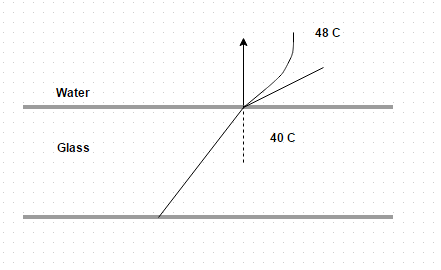This set of Heat Transfer Multiple Choice Questions & Answers (MCQs) focuses on “Reynolds Number”.
1. The ratio of inertia force to viscous force is known as
a) Grashof number
b) Reynolds number
c) Fourier number
d) Nusselt number
View Answer
Explanation: Reynolds number is indicative of the relative importance of inertial and viscous effects in a fluid motion.
2. Velocity within the given fields would be similar in magnitude, direction and turbulence pattern when
a) Nusselt number are different
b) Nusselt number are same
c) Reynolds number are different
d) Reynolds number are same
View Answer
Explanation: Reynolds number constitutes an important criterion of kinematic and dynamic similarity in forced convection heat transfer.
3. Reynolds number is given by the quantity
a) p V l/δ
b) 2 p V l/δ
c) 3 p V l/δ
d) 4 p V l/δ
View Answer
Explanation: p V 2 l 2/ δ V l.
Where, p is density
δ is viscosity
V is volume
l is length.
4. Air enters a rectangular duct measuring 30 cm by 40 cm with a velocity of 8.5 m/s and a temperature of 40 degree Celsius. The flowing air has a thermal conductivity 0.028 W/m K, kinematic viscosity 16.95 * 10 -6 m2/s and from empirical correlations the Nusselt number has been approximated to be 425. Find out the flow Reynolds number
a) 1.1719 * 10 6
b) 2.1719 * 10 6
c) 0.1719 * 10 6
d) 4.1719 * 10 6
View Answer
Explanation: R e = V d e/v.
5. Consider the above problem, find the convective heat flow coefficient
a) 24.71 W/m2 K
b) 34.71 W/m2 K
c) 44.71 W/m2 K
d) 54.71 W/m2 K
View Answer
Explanation: h = N U k/d e.
6. For laminar flow, Reynolds number should be
a) Less than 2300
b) Equal to 2300
c) Greater than 2300
d) Less than 4300
View Answer
Explanation: In laminar flow, the fluid particles move in flat or curved un-mixing layers or streams and follow a smooth continuous path.
7. For turbulent flow, Reynolds number must be
a) Less than 5000
b) Equal to 6000
c) Less than 6000
d) Greater than 6000
View Answer
Explanation: In turbulent flow, the motion of fluid particles is irregular, and it proceeds along erratic and unpredictable paths.
8. What is the value of convective coefficient of air and superheated steam in case of forced convection?
a) 30-900 W/m2 K
b) 30-700 W/m2 K
c) 30-300 W/m2 K
d) 30-400 W/m2 K
View Answer
Explanation: In forced convection, flow of fluid is caused by a pump, a fan or by the atmospheric winds. These mechanical devices provide a definite circuit for the circulating currents.
9. Heat is being transferred by convection from water at 48 degree Celsius to glass plate whose surface is exposed to water at 40 degree Celsius. The thermal conductivity of water is 0.6 W/m K and the thermal conductivity of glass is 1.2 W/m K. The spectral gradient of temperature in the water at the water glass interface is 10 -4 K/m. The heat transfer coefficient in W/m2 K is

a) 0.0
b) 750
c) 6.0
d) 4.8
View Answer
Explanation: q = h d t = 6000. Therefore, h = 6000/48 – 40.
10. For transient flow, the value of Reynolds number may vary between
a) 1450-9870
b) 1200-4500
c) 2300-6000
d) 6000-9000
View Answer
Explanation: The term transient designates a phenomenon which is time dependent.
Sanfoundry Global Education & Learning Series – Heat Transfer.
To practice all areas of Heat Transfer, here is complete set of 1000+ Multiple Choice Questions and Answers.
If you find a mistake in question / option / answer, kindly take a screenshot and email to [email protected]
- Apply for Chemical Engineering Internship
- Check Chemical Engineering Books
- Practice Chemical Engineering MCQs
- Check Mechanical Engineering Books
- Apply for Mechanical Engineering Internship
